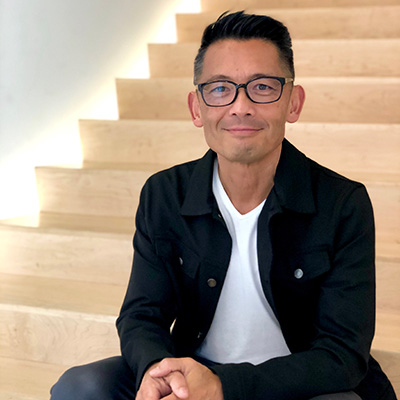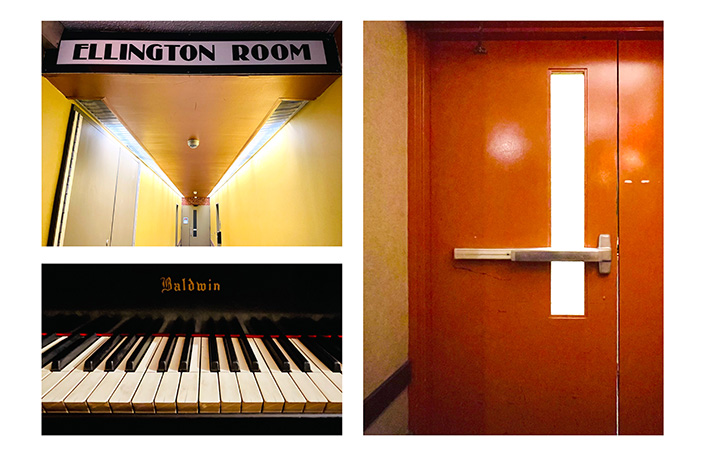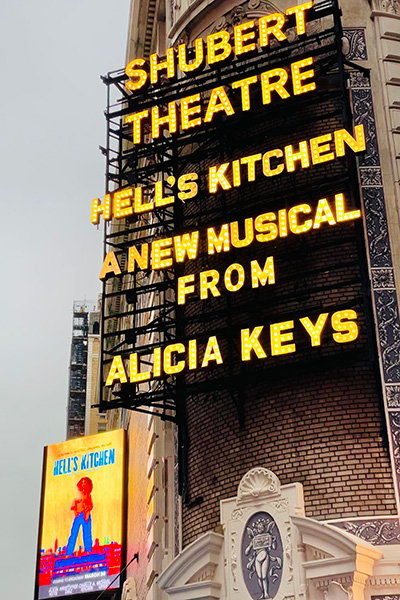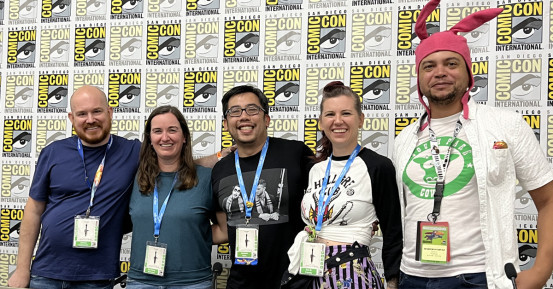Q&A: Robert Brill on Designing the Stage for Alicia Keys’ Musical ‘Hell’s Kitchen’
Story by:
Published Date
Story by:
Topics covered:
Share This:
Article Content
When his phone rang last fall with an invitation to design the stage for a musical by 15-time Grammy award winner Alicia Keys, Robert Brill answered with an enthusiastic ‘yes.’ A set designer with three Tony award nominations, Brill is professor of design and an alumnus of UC San Diego’s Department of Theatre and Dance.
We caught up with Brill prior to the March 28 Broadway premiere of the new musical, called “Hell’s Kitchen.” We learned that Brill has multiple connections to the project—from his friendship with UC San Diego classmate and “Hell’s Kitchen” Director Michael Greif to the intersections he and his family have with Alicia Keys’ story as a former resident of Hell’s Kitchen, a neighborhood in New York City. We also get an inside look at how the design concept took shape, and what audiences can expect during the upcoming show.

How did you become connected to this project?
“In the fall of 2022, Michael Greif—director of ‘Hell’s Kitchen’—contacted me about the new musical. Michael and I have been colleagues since our days as students at UC San Diego’s Department of Theatre and Dance. We were a few years apart—Michael was in his last year of the graduate directing program when I arrived as an undergraduate. Our paths initially crossed when he enlisted my help on a small part of his thesis production.
Our paths have continued to intersect throughout our careers. Michael established himself in New York, working at prestigious institutions like The New York Public Theatre and New York Theatre Workshop, where he developed and directed the musical ‘Rent’ with Jonathan Larsen. And in the mid-1990s, he returned to helm the La Jolla Playhouse (he had assisted director Des McAnuff here on the premiere of ‘Big River’ as a grad student). Michael and I have collaborated on one or two projects since then, and when he approached me about designing ‘Hell’s Kitchen,’ I of course said yes, and was honored and thrilled to be part of such a special project.”
I understand that the musical is semi-biographical. Tell us a little about the premise.
“Alicia is such an amazing artist, storyteller and musician. It’s a beautiful and genuine story inspired by a brief but defining chapter in her youth. The narrative revolves around 17-year-old Ali and the pivotal relationships with her mother, her first romantic partner and her introduction to music.
While incorporating some of Alicia’s iconic anthems, the musical goes beyond a typical jukebox production (a musical in which a majority of the songs are well-known). Her songs are re-contextualized and performed by multiple actors, adding depth to the narrative. There’s a whole new dimension to the music—a fresh perspective that resonates with audiences on many levels. It’s also an amazing company of actors, singers and dancers, and I’m thrilled to create an environment for their virtuosity.”
The musical is called “Hell’s Kitchen.” What is significant about this New York neighborhood?
“Despite its proximity to the theatre district, the neighborhood west of Times Square known as Hell’s Kitchen has a history of being dangerous. It underwent transformation in the 1970s with the construction of Manhattan Plaza—a housing complex initially intended as luxury apartments but later repurposed as affordable housing, particularly for individuals in the performing arts community. The two 45-story towers of Manhattan Plaza—a full city block bounded by 9th and 10th avenues and 42nd and 43rd streets, is where Alicia Keys spent her formative years, and forms the setting for ‘Hell’s Kitchen.’
My connection to this neighborhood runs deep. In the mid-1990s I lived just north of Manhattan Plaza on West 47th Street, and my daughter Sophia grew up in that vibrant community. In fact, her preschool was in the basement of Manhattan Plaza, and PS212 was her lower school, which shares the same building as the Professional Performing Arts School where Alicia had attended years before. Many of my daughter’s close friends lived in the Manhattan Plaza towers, so when the opportunity came up to work on this piece, I knew it would be meaningful on so many levels.”

How did you begin to conceptualize the scenic design for the musical?
“I started by immersing myself in her music—Alicia’s an extraordinary storyteller, not to mention having a popular playlist of anthems that are iconic to New York. On numerous visits to the city, I explored the neighborhood, retracing my steps and reconnecting with close friends who still live in Manhattan Plaza. I photographed the building, capturing it from different angles, and was able to get access to many of the spaces that are in the play and important to Alicia’s journey—like the Ellington Room, where she meets her mentor who inspires her and teaches her to appreciate music.

Next, I began exploring New York City, considering its dynamic essence—its ever-changing landscapes and diverse energy. You can’t travel far without experiencing something that physically and emotionally alters your perspective.
This study inspired a design characterized by abstract structural elements, echoing the city’s architectural rhythms. From Alicia’s childhood apartment in Manhattan Plaza, to the surrounding Hell’s Kitchen neighborhood of Midtown, to Gramercy Park and Alphabet City, your visual frame of reference constantly changes, even in proportion. It’s a wild, multi-layered, complex series of fragments—a collection of images, sights and sounds that assemble, sometimes haphazardly like a collage. This visual immersive puzzle is what inspired the scenic design.”
How did your exploration of Manhattan Plaza and New York City at large translate to a dynamic set design for “Hell’s Kitchen”?
“Because music is the heartbeat of the story, Michael and I began by exploring how an onstage band could represent the community of artists and musicians that was Ali’s creative hive and formed her appreciation of music. This evolved into two multi-story structures housing the band, symbolizing the Manhattan Plaza towers.
From there, we began to imagine a complex series of abstract structural elements, echoing the architecture and the rhythm of alternating balconies that make up the façade of the towers. All these elements are in motion throughout the evening, including the stage floor (a grid-like representation of streets and avenues), which features a large revolving turntable, allowing us to shift perspective and increase the kinetic potential of the staging.

Working in concert with Alicia, who was keen on evoking the dark and gritty streets of New York, we felt confident in this ever-changing and densely layered collage of moving—and sometimes disorienting—elements. Collaborating with our incredible design team, including lighting designer Natasha Katz, sound designer Gareth Owen, costume designer Dede Ayite and projection designer Peter Nigrini, our goal was to create a dynamic, shifting landscape meant to reflect the vibrancy of the city.”
The musical is transferring to a larger theater on Broadway. Did the stage design grow as well?
“‘Hell’s Kitchen’ premiered last fall at The New York Public Theater; it was performed in The Newman Theatre, which only seats 299 and is only 20’ tall. It was challenging to make the canyon-like nature of New York City legible with limited height, but still a thrill to be working in the theatre that’s debuted many iconic musicals, like ‘Hamilton’ and ‘A Chorus Line.’
This March the musical will premiere at Broadway’s Shubert Theatre. One of the most sought-after houses on Broadway, the Shubert seats 1,500 and will allow us to dramatically increase our set vertically. We’re currently in the process of fabricating new scenic elements that will expand the existing design to fill the height of the theater and engage with a much larger audience.”
You are an alumnus of UC San Diego’s Department of Theatre and Dance. How did your experience here impact your career?

“My undergraduate years at UC San Diego laid the foundation for my career and continues to shape who I am as a designer, collaborator and educator. As a first-gen transfer student with a background in architecture and a keen interest in magic and graphic design, I felt lucky to find the kind of supportive community that nurtured my diverse interests throughout high school, junior college and even a residency at the Oregon Shakespeare Festival. That level of encouragement and support made me realize that anything was possible, something that continues to inform me every day.
The Department of Theatre and Dance was always a hive of activity, and I was fortunate to have generous friends and mentors who championed my career trajectory—like founding Chair Arthur Wagner, who afforded me the opportunity to design a graduate production; or Des McAnuff (then artistic director of La Jolla Playhouse), who invited me to design the inaugural production in the Mandell Weiss Forum; or my wildly ambitious friends who founded Sledgehammer Theatre here on the UC San Diego campus. During that formative period, I discovered the value of learning from others and a belief that ‘if I’m the smartest person in the room, I’m in the wrong room.’ Luckily for me, I’m never the smartest and continue to be challenged and surrounded by inspiring students and colleagues.
Three decades into my career, I feel fortunate that each day offers a new set of challenges and adventures. I remain grateful and am reminded that opportunities exist—sometimes you have to find them, and sometimes you have to make them. I could have never imagined any of this happening, and to this day I still treat every project like it's my first.
Stay in the Know
Keep up with all the latest from UC San Diego. Subscribe to the newsletter today.



